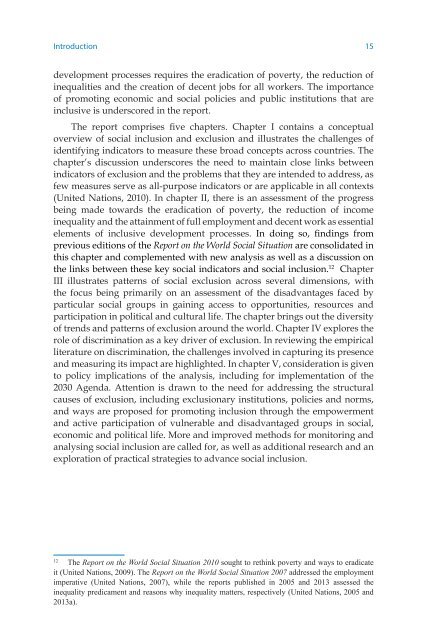Leaving no one behind the imperative of inclusive development
full-report
full-report
Create successful ePaper yourself
Turn your PDF publications into a flip-book with our unique Google optimized e-Paper software.
Introduction 15<br />
<strong>development</strong> processes requires <strong>the</strong> eradication <strong>of</strong> poverty, <strong>the</strong> reduction <strong>of</strong><br />
inequalities and <strong>the</strong> creation <strong>of</strong> decent jobs for all workers. The importance<br />
<strong>of</strong> promoting eco<strong>no</strong>mic and social policies and public institutions that are<br />
<strong>inclusive</strong> is underscored in <strong>the</strong> report.<br />
The report comprises five chapters. Chapter I contains a conceptual<br />
overview <strong>of</strong> social inclusion and exclusion and illustrates <strong>the</strong> challenges <strong>of</strong><br />
identifying indicators to measure <strong>the</strong>se broad concepts across countries. The<br />
chapter’s discussion underscores <strong>the</strong> need to maintain close links between<br />
indicators <strong>of</strong> exclusion and <strong>the</strong> problems that <strong>the</strong>y are intended to address, as<br />
few measures serve as all-purpose indicators or are applicable in all contexts<br />
(United Nations, 2010). In chapter II, <strong>the</strong>re is an assessment <strong>of</strong> <strong>the</strong> progress<br />
being made towards <strong>the</strong> eradication <strong>of</strong> poverty, <strong>the</strong> reduction <strong>of</strong> income<br />
inequality and <strong>the</strong> attainment <strong>of</strong> full employment and decent work as essential<br />
elements <strong>of</strong> <strong>inclusive</strong> <strong>development</strong> processes. In doing so, findings from<br />
previous editions <strong>of</strong> <strong>the</strong> Report on <strong>the</strong> World Social Situation are consolidated in<br />
this chapter and complemented with new analysis as well as a discussion on<br />
<strong>the</strong> links between <strong>the</strong>se key social indicators and social inclusion. 12 Chapter<br />
III illustrates patterns <strong>of</strong> social exclusion across several dimensions, with<br />
<strong>the</strong> focus being primarily on an assessment <strong>of</strong> <strong>the</strong> disadvantages faced by<br />
particular social groups in gaining access to opportunities, resources and<br />
participation in political and cultural life. The chapter brings out <strong>the</strong> diversity<br />
<strong>of</strong> trends and patterns <strong>of</strong> exclusion around <strong>the</strong> world. Chapter IV explores <strong>the</strong><br />
role <strong>of</strong> discrimination as a key driver <strong>of</strong> exclusion. In reviewing <strong>the</strong> empirical<br />
literature on discrimination, <strong>the</strong> challenges involved in capturing its presence<br />
and measuring its impact are highlighted. In chapter V, consideration is given<br />
to policy implications <strong>of</strong> <strong>the</strong> analysis, including for implementation <strong>of</strong> <strong>the</strong><br />
2030 Agenda. Attention is drawn to <strong>the</strong> need for addressing <strong>the</strong> structural<br />
causes <strong>of</strong> exclusion, including exclusionary institutions, policies and <strong>no</strong>rms,<br />
and ways are proposed for promoting inclusion through <strong>the</strong> empowerment<br />
and active participation <strong>of</strong> vulnerable and disadvantaged groups in social,<br />
eco<strong>no</strong>mic and political life. More and improved methods for monitoring and<br />
analysing social inclusion are called for, as well as additional research and an<br />
exploration <strong>of</strong> practical strategies to advance social inclusion.<br />
12<br />
The Report on <strong>the</strong> World Social Situation 2010 sought to rethink poverty and ways to eradicate<br />
it (United Nations, 2009). The Report on <strong>the</strong> World Social Situation 2007 addressed <strong>the</strong> employment<br />
<strong>imperative</strong> (United Nations, 2007), while <strong>the</strong> reports published in 2005 and 2013 assessed <strong>the</strong><br />
inequality predicament and reasons why inequality matters, respectively (United Nations, 2005 and<br />
2013a).
















